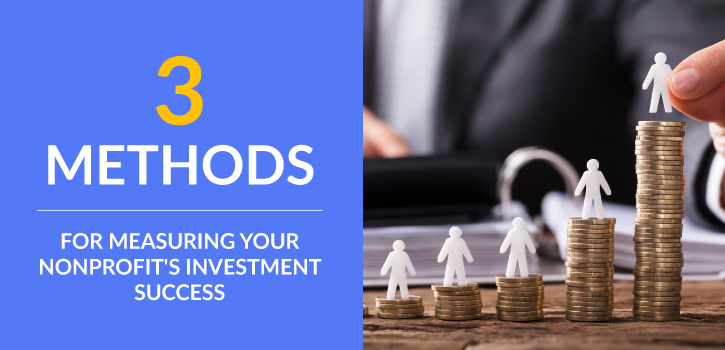3 Methods for Measuring Your Nonprofit’s Investment Success
Is your nonprofit’s investment strategy paying off? Understanding your investment portfolio’s performance is critical to establishing a healthy budget, determining future fundraising strategies, and providing a meaningful snapshot to stakeholders.
When evaluating your nonprofit investment performance, it’s essential to consider the following factors:
By combining these methods, you’ll be able to take a holistic view of your investment approach and make the best possible decisions for the success of your organization and community at large. Let’s dive in!
1. Return on Investment (ROI)
According to NPOInfo, return on investment (ROI) represents the total revenue your organization gains over the total investment cost, including the principal amount and ongoing fees.
When looking at your nonprofit’s investment success, return on investment is the most important measurement to consider. For nonprofits, we recommend looking at your ROI through two different lenses: ROI over a period of time and ROI compared to the market.
ROI Over a Period of Time
ROI over a period of time considers both capital gains and dividends and can be used to analyze the overall performance of a nonprofit’s investment portfolio.
To calculate ROI over a period of time, simply divide your investment return (current value minus investment cost) by the cost of your initial investment.
ROI = (Investment Return / Investment Cost) × 100%
For example, if you invested $100,000 in a mutual fund and it gained 10% over the course of a year, your ROI would be 10%.
ROI Compared to the Market
ROI compared to the market is a way to measure how well your investments performed compared to a benchmark index. In this sense, it focuses on the difference between the return you earned and the return you could have earned by investing in a low-cost, passive benchmark index.
For example, if the S&P 500 gained 10% over a year, and your investment earned 13%, your ROI compared to the market would be 3%.
Additionally, as inflation rates rise, you should compare your ROI against current rates. If inflation is at 9%, but your investment account returns 8%, your fund is actively losing its value, and you should reconsider your investment strategy.
2. Risk
In addition to ROI, you should consider the riskiness of your investments when evaluating your investment performance. A successful high-risk investment strategy can quickly become a very unsuccessful one.
While measuring the risk of your investment strategy is a complex process, for nonprofits, we recommend you begin by evaluating it in two forms: volatility and drawdowns.
Volatility
Volatility is a calculation of how much your investments fluctuate in value over time. Measuring volatility can help your organization understand the predictability of an investment fund’s growth. For example, a fund that gained 10% one year, lost 12% the following year, and gained 16% in a third year would be considered an unpredictable and thus volatile investment.
Volatility is particularly important to consider with short-term, time-bound investments where you can’t wait for the value to swing upward before removing the funds. However, in general, the higher the volatility, the higher the risk.
Drawdowns
A drawdown tells you how much an investment or fund has lost in value over a specific period of time. Drawdowns are important to consider in your performance analysis because they provide historical insight into how much your investments can lose. Much like volatility, the higher the drawdown, the higher the risk.
Generally, a diversified portfolio, alongside ongoing fundraising activities, such as events, donations, and matching gifts, will help your nonprofit reduce the potential risk in your investment portfolio and perform better long-term. For example, if you have a portfolio diversified across multiple asset classes, such as stocks, bonds, and cash, your overall investment is less likely to suffer if one of those assets performs poorly.
3. Liquidity
As an investment performance metric, liquidity tells you how easily you can convert your investment into cash and access your money in an emergency. While not all your funds will be liquid, nonprofits should aim to have an easily-accessible reserve fund of nine to twelve months of their operating budget in a conservative and diversified portfolio.
Endowment funds, for instance, often carry restrictions that regulate the amount your organization can withdraw each year and where that money can go. Similarly, if you have a portfolio that is composed of only stocks, you may have a difficult time quickly converting your investments into cash in the case of an emergency. On the other hand, if you have a portfolio composed of cash and bonds, you will likely have an easier time converting your investments into cash.
To measure liquidity, consider the percentage of your investment portfolio that is composed of cash and cash equivalents. For example, if you have a portfolio consisting of 50% cash and 50% stocks, your portfolio would be considered 50% liquid.
The Bottom Line
By measuring return on investment, risk, and liquidity, you will be able to get a clearer picture of how your nonprofit’s investments are performing.
However, for many nonprofits with limited resources, this information can often be challenging to find, share, and act on. To improve transparency and accessibility as well as increase your investing success, it’s important to consider the investment tools you use. Infinite Giving’s guide to nonprofit reserve funds recommends that you ask the following questions of providers when considering where to invest your funds:
- How will you support my nonprofit’s goals?
- What are the associated service and investment fees?
- How do I access, deposit, and withdraw funds?
- What security features do you offer?
- What investment portfolio options do you offer?
- Can I generate and share custom reports with my stakeholders?
- Do you offer accessible customer service and expert advice?
With the right investment tools and measurement strategies, you can better engage key stakeholders and donors, make financially sound investment decisions, generate more income for your organization, and make a greater impact in your community.


